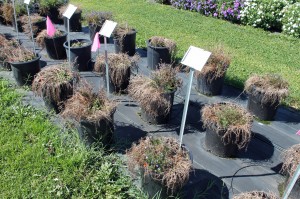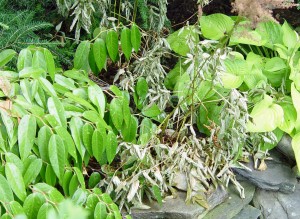10 Plants That Are Better in Pots than in the Garden
While you’re doing your plant-shopping, consider that some plants make a good first impression but quickly lose their luster once they move in with you.
Others get off to a homely, underwhelming start in their garden-center pots but flourish like botanical swans once in open ground.
Knowing which is which helps invest your plant-buying dollars more wisely.
To help with that, here’s my list of top 10 plants that look better in pots than the garden. To see the reverse — plants that look better in the garden than in pots at the garden center — click here.
Better in Pots
1.) Annual lobelia. These compact, dainty annuals grab lots of eyes with their rich blue flowers. Some varieties bloom sky blue, and others bloom a deeper, darker blue than any flower I’ve seen.
The problem is lobelia doesn’t do heat. By July, they’re almost always out of bloom and often totally fried to a crisp.
2.) Pansies/violas. These closely related flowers are also cool-weather lovers. They come in all sorts of vibrant colors with their cutesy faces.
In my experience, they end up in the same summer boat as lobelia – if the rabbits don’t eat them first.
3.) Azaleas. Azaleas have the good sense to hit peak bloom at the same time the bulk of people are planting-shopping in May.
Most are gorgeous balls of solid color in nursery pots, but way too many of them croak or become lacebug-infested in lousy soil, too much sun and summer drought.
4.) Mountain laurel. Our official state flower (a woodland broadleaf evergreen shrub) also looks great in April/May with its shiny leaves and pretty pink, rose or white flowers.
Unfortunately, this species is very picky about growing conditions, much preferring the cool Poconos woods (or the greenhouse) to your baked-clay back yard. A majority are dead in 2 to 3 years… or looking like they’d be better off if they were.
5.) Gaillardia (blanket flower). This prairie-native perennial doesn’t mind the heat and dry, but it tends to be short-lived in the landscape – especially in wet clay over winter.
The bright gold/orange/red flowers cry out, “Buy me!” in spring, but that cry quickly changes to, “Deadhead me!” after the flowers brown.
6.) Astilbe. Astilbes are striking in regularly watered nursery pots with their showy early-summer flower spikes of pink, red, rose or white.
Keep them damp, afternoon-shaded and away from moisture-sucking tree roots, and they can continue to perform. However, I see way too many that have fried to the ground in August.
7.) Lady’s mantle. The waxy wide leaves and soft chartreuse spring flowers of this perennial make it seem like a sadly under-used choice at buying time.
Like astilbe, lady’s mantle just doesn’t take kindly to our summer heat. Most seem to disappear after a few years in our landscapes. This is a plant that wants to live in England.
8.) Garden phlox. I’d have this summer-blooming native perennial all over my gardens if it weren’t for one major drawback – powdery mildew disease that ruins the foliage just as the blooms fade.
All look great in pots, but only a few resist mildew in the garden (‘Jeana,’ ‘Blushing Shortwood,’ ‘Katherine’ and ‘Robert Poore’ are four good ones).
9.) Heath and heather (Erica and Calluna). Both of these similar cutesy little shrubs look very enticing with their dainty pinkish to lavender flowers in the cool season.
The problem is they’re much happier in moderate climates like England, Ireland and the Pacific Northwest than our more extreme climate.
These often end up short-lived in landscapes due to things we can offer but don’t (i.e. good drainage, acidy soil, no excess mulch, no heavy clay) along with things we can’t do much about (i.e. sub-zero winters and 100-degree summers).
When Longwood Gardens gave up trying to grow a bank full of them, I knew it wasn’t just me.
10.) Gazania. This daisy-like annual with hot colors of gold, orange and red, gazania is fine in the heat.
The down side is that the flowers refuse to open unless the sun is shining, which renders them boring about half of the time.
Ones I’ve tried never really seem to grow and fill in either. By mid-summer, they’re the same size as the day I planted them.











